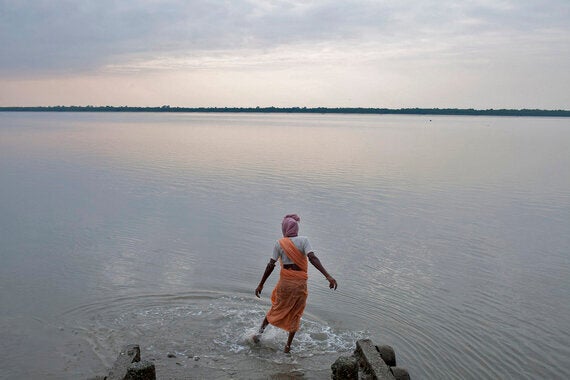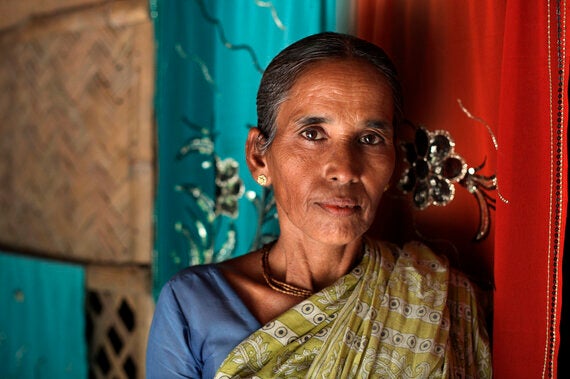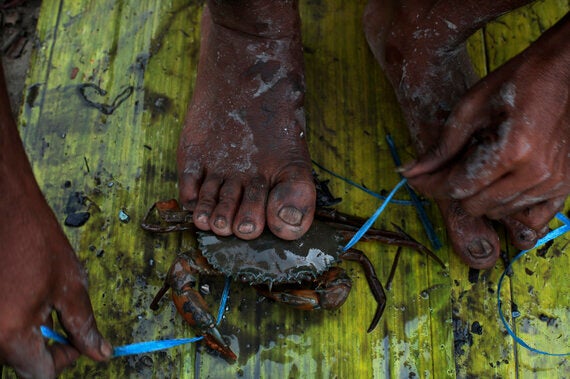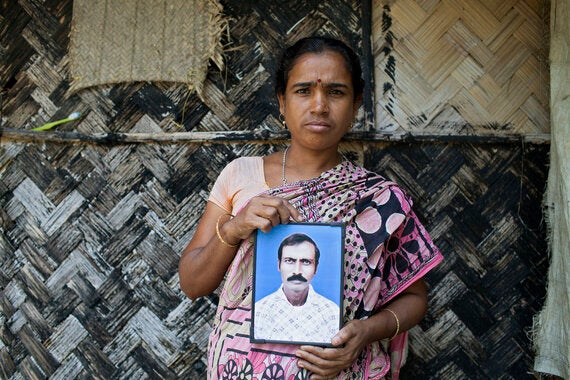
More on this story:The tiger, the fisherman, his wife and our future
In November last year I travelled with a photographer to the Sundarbans, on the north east Indian coastline, to investigate the impact of climate change in an area at particular risk from global warming.
The story could have begun with rising sea levels, which are twice the global average. We could have explored the increasingly intense cyclone and storm surges that batter the coastline. But a chance encounter, over a good cup of India chai, led us in a rather different and unexpected direction.
The Sundarbans, which span India and Bangladesh, is a special place - a rich and diverse ecosystem, a vast carbon sink and the world's largest mangrove forest. The sort of place where your bed, despite its mosquito net, is jammed full of tiny creatures desperate to share the space with you.
It's also home to the Royal Bengal Tiger, notorious for attacking locals who, driven by poverty, venture into the mangroves to fish the channels, hunt for crabs and collect honey.
According to the locals on Basanti Island, a district nearby known as Jharkhali was full of women who had lost their husbands to tiger attacks. They were known as the 'tiger-widows'. While not immediately apparent as a climate-related issue, we were gripped and wanted to find out more.
Over the course of two days we met more than a dozen tiger widows, interviewing as many as time allowed. Most seemed happy to talk, pleased that someone from the outside world was interested in their plight. Every house we visited had a story to tell; a neighbour who was also widowed, a relative who survived an attack, a friend who disappeared. And we also met survivors whose animated and graphic accounts of trying to fight off an attacking tiger sounded like the stuff of fable.
Jharkhali is located in what is known as the 'buffer zone'; land that is directly opposite the forest where the tigers live but divided by a wide river. The residents are poor, very poor, and because of salination from rising sea levels are unable to farm their land. Many are dependent on the fruits of the forest, fish and honey, to survive. The men go daily, illegally, into the forest while the women wait at home with little to do but pray for their safe return.

Avijit Dhali, a 23-year-old fisherman whose father was attacked and killed by a tiger five years ago told me:
"I am in a constant fear while going fishing. But I have no choice because to live we need food. It is a big responsibility for me. There is no one else in the family to take such responsibility."
A number of the tiger-widows we met claimed they had known something was wrong on the day their husbands died. Each spoke of a feeling of unease, an anxiety, in some cases a loss of appetite.

Minati Roy, 42, was one of them:
"On the day my husband was attacked I was not in a good mood. Some unexpected occurrence or bad news was going to come to my heart. I could predict it. Some misfortune was going to happen."
Many held a strong belief that a government programme to rear tigers, by injecting them so that they can breed 12 times faster than normal, is putting their loved ones at risk of attack as the numbers of tigers swell.
This isn't true. In fact tiger numbers are depleting fast. This year, it's estimated that fewer than 100 remain in the Indian Sundarbans. But it's a myth that has stuck.
Back in Kolkata we met Joydip Kundu, a leading conservationist and director at the Society for Heritage and Ecological Researches (SHER). He confirmed tigers attack because they are hungry and not because they are blood thirsty 'man-eaters'. They simply see the fishermen and honey collectors as prey.

"The tiger is already negotiating its survival in a tough landscape where there is no adequate prey base. It has to survive on fish, crabs, honey and small animals. The tiger will eat whatever comes its way in order to survive. So when a tiger sees a human being walking in the forest, he sees it as his prey.
"Both parties are equally desperate. The tiger is desperate and the people are also desperate."
Mr Kundu added: "If ultimately the sea continues to rise, the villages will be washed away and the land will shrink. Not only will tigers lose their habitat but the local population will also be forced to migrate to cities far away - creating a huge number of environmental refugees."
Dr Sugata Hazra, a climate scientist at Jadavpur University in Kolkata also agrees. He told us "Saline water is flowing over the embankments, which makes living in the Sundarbans very difficult." He said: "a lot of people are forced to migrate."
In fact several of the widows we met had already sent their children away to find work; fearing that because they couldn't grow enough food to live, their children would also fall victim to the same fate as their father.

Sabitri Mondal's son was just 13 years old when she sent him to Kolkata: ""When my husband died I had to continue the household. I took up some work in the field and my son started working outside as a labourer. He didn't want to catch fish here after his father's accident."
And so by following the tiger widows we had inadvertently found a climate change connection after all. Increased salination of land is forcing thousands of people to seek food and an income from forest resources, putting lives at risk and families in jeopardy.
Christian Aid is helping poor communities adapt to climate change. As well as helping communities to develop sustainable ways to feed their families. Christian Aid campaigns at a regional, national and international level to ensure decision makers take action.
To find out more about this story visit Christian Aid's new interactive, The tiger, the fisherman, his wife and our future, which tells the story of the delicate balancing act between humankind, animal and the climate in this fragile part of the world.
This blog was first published in Geographical Magazine. Photos by Anastasia Taylor-Lind